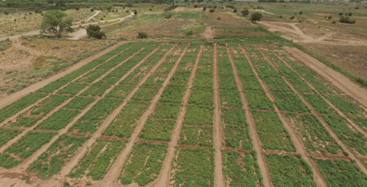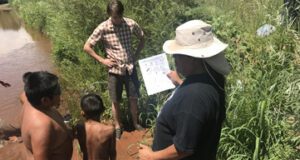
Article Written By: Roger Fragua
Many of the 577+ Federally recognized American Indian Tribes are agricultural Tribal communities with vast histories in farming. Collectively they own more than 53 million acres, have primary water rights, have a population of 3 million, and are growing at 4% per year. Many of the Puebloan communities in the southwest have been utilizing the same seed, the same waters, and the same soils for centuries. Agriculture is the very DNA that has made the people and the communities what they are. Fast forward to a more modern life way and wage economies. Farming becomes more challenging, as many travel an hour each way to work, put in a 12 hour work day and then do their farming on top of that. Put a worldwide pandemic on top of that and we have farming in 2020 and 2021.
When the Pandemic first hit our community at the Pueblo of Jemez in Northwestern New Mexico, we were concerned about access to food. The closest grocery store is 47 miles away and the local convenience store stocks mostly diabetes and obesity foods such as chips, soda, and candy. Our Cultural Leader, Joseph Toledo, gathered a few people and advocated calm and confidence amidst the headlines and news stories of empty grocery shelves. He suggested that since the beginning of time, we have had a symbiotic relationship with the natural world full of abundant resource with many edible and medicinal plants. We began foraging our landscapes for diverse varieties of these plants. We engaged our youth in virtual workshops to help support the identification of the correct plants. This was immensely helpful in restoring confidence in our cultural ways and dealing with the anxiety from being bombarded by the daily newsreels with death counts. It helped to get us outside and in small family groups to preserve our cultural ways. This was helpful but not the entire picture.
We knew that we would have to plant, and plant big in the spring. We had been practicing cover crop and no –till in our agriculture areas as a practice for several years and getting great advice and seeds from Keith Berns at Green Cover Crop Seeds.

We historically blend cover crops, no-till and use of humates mined locally as our organic fertilizers into our practice for farming. We plant our traditional chili, corn, melons, and squash from our Heritage seeds. But with the short supplies and increasing costs at the grocery stores, we wanted to plant other non-traditional vegetable crops as well. We began looking for organic and non-GMO seed suppliers but soon found that toilet paper, meat and seeds were in short supply. After a frustrating search, I called Keith and he said he could help (as usual) and we started to order MILPA seeds from Green Cover Seed. After we had the first order of MILPA in the ground, we reached out to Tribes across the US and started to support their efforts for MILPA Resiliency Gardens. We brought in big bags of MILPA seeds and broke them into smaller bags and sent seeds to more than 600 Native and Tribal farms from Alaska to Florida and California to Maine and many places in between.
We received many requests for “How to” and more specifics on planting the MILPA Blend seeds into Resiliency Gardens. We spent a lot of time with individuals, families, and communities alike. It felt good to get the seeds into the soil all across Indian Country. With the help of Green Cover, the Native American Agriculture Fund, and various Tribal organizations, we were able to donate all the MILPA seed. All the produce and vegetables were grown and consumed on Indian lands for Native peoples.
We are working on our future MILPA Seed orders now and are planning to work more efficiently with Tribal organizations across the country. We highly recommend to anyone wanting to make a difference to consider joining the Green Cover Seed MILPA project and invite others to help support growing their own food!! 
This article first appeared in the 8th Edition of Green Cover's Soil Health Resource Guide.
Also check out the 10th edition, our latest Soil Health Resource Guide, over 90 pages packed with scientific articles and fascinating stories from soil health experts, researchers, farmers, innovators, and more! All as our complimentary gift to you, a fellow soil health enthusiast!